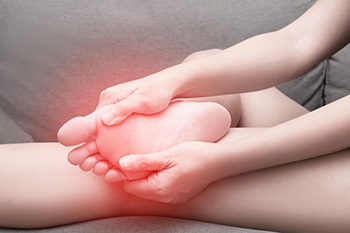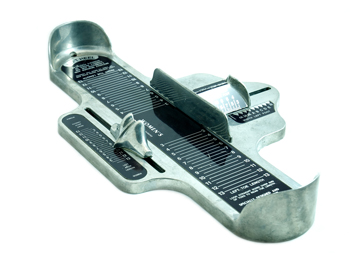
(616) 846-3400
Fax: (616) 846-3406

(616) 846-3400
Fax: (616) 846-3406

Forefoot disorders are common and can significantly impact a person's ability to walk and may affect their overall quality of life. One prevalent issue is metatarsalgia, which causes pain in the front part of the foot. To alleviate metatarsalgia, individuals can use metatarsal pads, bars, or forefoot cushions. Another common problem is hallux valgus, characterized by the deviation of the big toe towards the other toes. Treatment options for hallux valgus include toe spreaders, valgus splints, and bunion shields. Hallux limitus and hallux rigidus, which cause limited movement in the big toe, can benefit from kinetic wedge foot orthoses or rocker soles. Additionally, hammer, claw, and mallet toes, which involve unusual bending of the smaller toes, can be managed with toe sleeves, padding, or metatarsal off-loading insoles. Morton's neuroma, a painful condition affecting the metatarsal area due to a benign nerve growth, can be relieved through the use of metatarsal bars, plantar pads, or cushioned insoles. It is important for individuals with these forefoot disorders to avoid wearing tight-fitting or high-heeled shoes and instead opt for comfortable footwear. If you suffer from forefoot pain, including toe pain, it is suggested that you make an appointment with a podiatrist for a proper diagnosis and appropriate management strategies.
Foot Pain
Foot pain can be extremely painful and debilitating. If you have a foot pain, consult with Dr. Robbi Young from Grand Haven Foot & Ankle. Our doctor will assess your condition and provide you with quality foot and ankle treatment.
Causes
Foot pain is a very broad condition that could be caused by one or more ailments. The most common include:
Diagnosis
To figure out the cause of foot pain, podiatrists utilize several different methods. This can range from simple visual inspections and sensation tests to X-rays and MRI scans. Prior medical history, family medical history, and any recent physical traumatic events will all be taken into consideration for a proper diagnosis.
Treatment
Treatment depends upon the cause of the foot pain. Whether it is resting, staying off the foot, or having surgery; podiatrists have a number of treatment options available for foot pain.
If you have any questions, please feel free to contact our office located in Grand Haven, MI . We offer the newest diagnostic and treatment technologies for all your foot care needs.

In the world of podiatry, the Brannock device stands as an indispensable tool, forging a vital connection between podiatrists and accurate foot measurements. This device, designed with precision and ergonomic considerations, facilitates the podiatrist's ability to assess the unique characteristics of an individual's feet. Serving as more than just a sizing tool in retail, the Brannock device aids podiatrists in diagnosing and addressing various foot-related conditions. Podiatrists leverage the Brannock device to gather critical data on foot length, width, and arch structure, contributing to a comprehensive understanding of a patient's foot anatomy. This nuanced information guides the podiatrist in recommending appropriate footwear, orthotic interventions, or customized treatment plans tailored to the individual's specific foot structure. The Brannock device, with its meticulous measurements, not only enhances the accuracy of diagnosis but also plays a pivotal role in advancing personalized and effective podiatric care. It is suggested that you visit a podiatrist who can show you how the Brannock device can determine what your correct shoe size is.
Getting the right shoe size is an important part of proper foot health. Seek the assistance of Dr. Robbi Young from Grand Haven Foot & Ankle. Our doctor will provide the care you need to keep you pain-free and on your feet.
Getting the Right Shoe Size
There are many people who wear shoes that are the incorrect size, negatively affecting their feet and posture. Selecting the right shoes is not a difficult process, so long as you keep several things in mind when it comes to choosing the right pair.
As our feet hold our body weight and keep us moving, it is important to treat them right. Picking the right pair of shoes can provide your feet comfort and mobility without pain.
If you have any questions, please feel free to contact our office located in Grand Haven, MI . We offer the newest diagnostic and treatment technologies for all your foot care needs.

Taking care of your feet as a runner is essential for a comfortable and injury-free experience. Start by carefully choosing your gear, especially your footwear, to prevent running injuries. Ensure a snug fit around the heel and instep to prevent friction and blisters, while leaving enough space in the toe box to accommodate downhill running and avoid bruised toenails. Choose moisture-wicking, anti-blister socks, and combine them with anti-chafe or diaper cream for lasting protection during long runs. While running, be attentive to any discomfort and take a brief pause to shake out your shoes, preventing hot spots and blisters. Consider using gaiters to shield your feet from external elements and eliminate the need for mid-run shoe cleanouts. Keep your toenails trimmed, moisturize your feet regularly, and use baby powder to keep them fresh and dry. Additionally, file down calluses to maintain a balance that prevents cracking and potential infections. Incorporate foot exercises such as the towel scrunch and resistance band calf stretch to prevent conditions like plantar fasciitis. It is suggested that you consult a podiatrist promptly if you notice any changes in your toenails or experience foot or ankle discomfort.
All runners should take extra precaution when trying to avoid injury. If you have any concerns about your feet, contact Dr. Robbi Young of Grand Haven Foot & Ankle. Our doctor will treat your foot and ankle needs.
How to Prevent Running Injuries
There are a lot of mistakes a runner can make prior to a workout that can induce injury. A lot of athletes tend to overstretch before running, instead of saving those workouts for a post-run routine. Deep lunges and hand-to-toe hamstring pulls should be performed after a workout instead of during a warmup. Another common mistake is jumping into an intense routine before your body is physically prepared for it. You should try to ease your way into long-distance running instead of forcing yourself to rush into it.
More Tips for Preventing Injury
If you have any questions, please feel free to contact our office located in Grand Haven, MI . We offer the newest diagnostic and treatment technologies for all your foot care needs.

Plantar fasciitis, a common foot condition characterized by inflammation and degeneration of the tissue supporting the sole of the foot, can cause a great deal of pain. Orthotics are known to be helpful in eliminating sharp heel pain, particularly in the morning or after prolonged periods of sitting. The two primary causes associated with plantar fasciitis are muscle imbalance and poor foot biomechanics. The main types of orthotics that can provide much needed support include heel cups or pads, and shoe inserts. Heel cups are small inserts for the back of your shoe that lift the heel slightly. This reduces tension on the Achilles tendon, subsequently easing stress on the plantar fascia. Additionally, the cushioning effect helps to absorb shock. Experts suggest wearing heel cups in both shoes to avoid leg length discrepancies that could lead to further issues in the foot, knee, and back. Shoe inserts provide support beyond the heel. With a deep heel cup and contoured shape, they provide stability and biomechanical support. Half length insoles fit under the heel and arch, leaving the toes free. To find out which type of orthotics for plantar fasciitis is best for you, it is suggested that you schedule an appointment with a podiatrist for an exam and treatment options.
Plantar fasciitis can be very painful and inconvenient. If you are experiencing heel pain or symptoms of plantar fasciitis, contact Dr. Robbi Young from Grand Haven Foot & Ankle. Our doctor can provide the care you need to keep you pain-free and on your feet.
What Is Plantar Fasciitis?
Plantar fasciitis is the inflammation of the thick band of tissue that runs along the bottom of your foot, known as the plantar fascia, and causes mild to severe heel pain.
What Causes Plantar Fasciitis?
How Can It Be Treated?
While very treatable, plantar fasciitis is definitely not something that should be ignored. Especially in severe cases, speaking to your doctor right away is highly recommended to avoid complications and severe heel pain. Your podiatrist can work with you to provide the appropriate treatment options tailored to your condition.
If you have any questions please feel free to contact our office located in Grand Haven, MI . We offer the newest diagnostic and treatment technologies for all your foot and ankle needs.